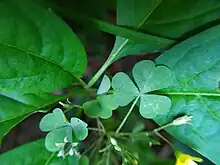| Golovinomyces orontii | |
|---|---|
.jpg.webp) | |
| On leaf of Vinca minor, Poland, Trzciana, województwo małopolskie | |
| Scientific classification | |
| Domain: | Eukaryota |
| Kingdom: | Fungi |
| Division: | Ascomycota |
| Class: | Leotiomycetes |
| Order: | Erysiphales |
| Family: | Erysiphaceae |
| Genus: | Golovinomyces |
| Species: | G. orontii |
| Binomial name | |
| Golovinomyces orontii V.P. Heluta | |
| Synonyms | |
|
Erysiphe orontii | |

Golovinomyces orontii is a species of fungus that causes powdery mildew disease and it is in the family Erysiphaceae. It is an obligate biotroph that infects plants in several families including Acanthaceae, Asteraceae,[1] Brassicaceae,[2] Cucurbitaceae,[3] and Lamiaceae.[4]
Taxonomy
Previously known as Erysiphe orontii, by Castagne (1851).[5] It is now known by Golovinomyces orontii by Heluta[6][7] (1988).
Description
Causes powdery mildew disease in multiple families including Acanthaceae, Asteraceae, Brassicaceae, Cucurbitaceae, etc. Conidia is produced on the surface[8] of the infected plant and that as well as hyphal growth gives it its white powdery appearance. Conidia are dispersed through the wind, water droplets, and similar methods to nearby plants to start new infections. The mycelium is able to absorb nutrients through haustoria.[9]
Disease symptoms
When Golovinomyces orontii infects its host plants, it causes a disease commonly known as powdery mildew. This gives the appearance of white, powdery sections on the surface of the plant. These powdery sections are caused by an abundance of conidia and mycelium.[10] This can lead to deformation, discoloration, reduced growth, and death in the host plant[11]
Lifecycle
The lifecycle begins when a conidia lands on the surface of a host plant. The conidia then develop germ tubes,[12] forming an appressorium,[13] that later forms into haustoria. These haustoria are used to siphon nutrients needed for growth.
Golovinomyces orontii completes a full life cycle within a few days.[14] The fungus produces new conidia asexually, which are easily dispersed to nearby susceptible plants. These conidia can initiate new infections, leading to the spread of the disease.
Ascomata (chasmothecia) are rarely formed on most hosts.[15] Chasmothecia may form under unfavorable conditions. Chasmothecia are resistant structures that protect the sexual spores (ascospores) of the fungus. They can remain viable for extended periods and serve as a means of survival until conditions become favorable again.
Management and control
The control of Golovinomyces orontii and powdery mildew diseases generally involves a combination of chemical and nonchemical strategies. Nonchemical strategies include; proper plant spacing, pruning and removing infected plant parts, avoiding overhead irrigation, improving ventilation, and crop rotation. Natural Fungicides[16] by be used as well. In severe cases, fungicides can be applied, but it is important to minimize the environmental risk of these fungicides and the prevention of resistance. For many vegetable crops, sulfur, copper-based products, chlorothalonil, horticultural oil, potassium bicarbonate, and Bacillus subtilis can be used for powdery mildew control.
References
- ↑ Qiu, Penglei; Nguyen, Vanninh; Guan, Guanxiu; Li, Yu; Takamatsu, Susumu; Liu, Shuyan (2018-08-01). "Occurrence of powdery mildew caused by Golovinomyces orontii on Lactuca sativa var. ramosa (lettuce) in China". Crop Protection. 110: 108–111. doi:10.1016/j.cropro.2018.04.005. ISSN 0261-2194. S2CID 90438631.
- ↑ Vági, Pál; Kovács, Gábor M.; Kiss, Levente (2007-01-01). "Host range expansion in a powdery mildew fungus (Golovinomyces sp.) infecting Arabidopsis thaliana: Torenia fournieri as a new host". European Journal of Plant Pathology. 117 (1): 89–93. doi:10.1007/s10658-006-9072-x. ISSN 1573-8469. S2CID 10154459.
- ↑ Pirondi, A.; Pérez-García, A.; Battistini, G.; Muzzi, E.; Brunelli, A.; Collina, M. (November 2015). "Seasonal variations in the occurrence of Golovinomyces orontii and Podosphaera xanthii, causal agents of cucurbit powdery mildew in Northern Italy: Epidemiology of cucurbit powdery mildew in Northern Italy". Annals of Applied Biology. 167 (3): 298–313. doi:10.1111/aab.12225.
- ↑ Garibaldi, A.; Bertetti, D.; Minerdi, D.; Gullino, M. L. (May 2007). "First Report of Powdery Mildew Caused by Golovinomyces orontii (Erysiphe orontii) on Lamium galeobdolon in Italy". Plant Disease. 91 (5): 635. doi:10.1094/PDIS-91-5-0635B. ISSN 0191-2917. PMID 30780724.
- ↑ Braun, U.; Shin, H.D.; Takamatsu, S.; Meeboon, J.; Kiss, L.; Lebeda, A.; Kitner, M.; Götz, M. (2019-03-01). "Phylogeny and taxonomy of Golovinomyces orontii revisited". Mycological Progress. 18 (3): 335–357. doi:10.1007/s11557-018-1453-y. ISSN 1861-8952. S2CID 255304107.
- ↑ "Dr V.P. Heluta". www.cybertruffle.org.uk. Retrieved 2023-05-06.
- ↑ "Golovinomyces orontii (ERYSPP)[Overview]| EPPO Global Database". gd.eppo.int. Retrieved 2023-05-06.
- ↑ Schlicht, Markus; Kombrink, Erich (2013). "The role of nitric oxide in the interaction of Arabidopsis thaliana with the biotrophic fungi, Golovinomyces orontii and Erysiphe pisi". Frontiers in Plant Science. 4: 351. doi:10.3389/fpls.2013.00351. ISSN 1664-462X. PMC 3766854. PMID 24058365.
- ↑ "Home - Golovinomyces orontii MGH1 v4.0". mycocosm.jgi.doe.gov. Retrieved 2023-05-06.
- ↑ "Powdery Mildew". CT.gov - Connecticut's Official State Website. Retrieved 2023-05-06.
- ↑ Garibaldi, A.; Bertetti, D.; Gullino, M. L. (May 2007). "First Report of Powdery Mildew Caused by Golovinomyces orontii (Erysiphe orontii) on Petunia × hybrida in Italy". Plant Disease. 91 (5): 632. doi:10.1094/PDIS-91-5-0632B. ISSN 0191-2917. PMID 30780715.
- ↑ Koike, S. T.; Saenz, G. S. (June 2005). "First Report of Powdery Mildew Caused by Golovinomyces orontii on Corn-Salad in the United States". Plant Disease. 89 (6): 686. doi:10.1094/PD-89-0686C. ISSN 0191-2917. PMID 30795411.
- ↑ Jiang, Zhenhong; Dong, Xiaobao; Zhang, Ziding (2016-01-11). "Network-Based Comparative Analysis of Arabidopsis Immune Responses to Golovinomyces orontii and Botrytis cinerea Infections". Scientific Reports. 6: 19149. Bibcode:2016NatSR...619149J. doi:10.1038/srep19149. ISSN 2045-2322. PMC 4707498. PMID 26750561.
- ↑ Jiang, Zhenhong; Dong, Xiaobao; Zhang, Ziding (2016-01-11). "Network-Based Comparative Analysis of Arabidopsis Immune Responses to Golovinomyces orontii and Botrytis cinerea Infections". Scientific Reports. 6: 19149. Bibcode:2016NatSR...619149J. doi:10.1038/srep19149. ISSN 2045-2322. PMC 4707498. PMID 26750561.
- ↑ Pirondi, A.; Kitner, M.; Iotti, M.; Sedláková, B.; Lebeda, A.; Collina, M. (August 2016). "Genetic structure and phylogeny of Italian and Czech populations of the cucurbit powdery mildew fungus Golovinomyces orontii inferred by multilocus sequence typing". Plant Pathology. 65 (6): 959–967. doi:10.1111/ppa.12480.
- ↑ Rongai, Domenico; Cerato, Claudio; Lazzeri, Luca (2009-08-01). "A natural fungicide for the control of Erysiphe betae and Erysiphe cichoracearum". European Journal of Plant Pathology. 124 (4): 613–619. doi:10.1007/s10658-009-9448-9. ISSN 1573-8469. S2CID 20308667.